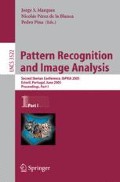Abstract
A new secret color image sharing scheme based on two-dimensional memory cellular automata, is proposed. Such protocol is of a (n,n)-threshold scheme where the secret image to be shared is considered as one of the initial configurations of the cellular automata. The original idea is to study how a reversible model of computation permits to compute the shares and then using the reverse computation in order to recover the original image. The scheme is proved to be perfect and ideal, and resistant to the most important attacks such as statistical attacks.
Access this chapter
Tax calculation will be finalised at checkout
Purchases are for personal use only
Preview
Unable to display preview. Download preview PDF.
References
Alonso-Sanz, R.: Reversible cellular automata with memory: two-dimensional patterns from a single seed. Physica D 175, 1–30 (2003)
Álvarez Marañón, G., Hernández Encinas, A., Hernández Encinas, L., Martín del Rey, A., Rodríguez Sánchez, G.: Graphics cryptography with pseudorandom bit generators and cellular automata. In: Palade, V., Howlett, R.J., Jain, L. (eds.) KES 2003. LNCS (LNAI), vol. 2773, pp. 1207–1214. Springer, Heidelberg (2003)
Blakley, G.R.: Safeguarding cryptographic keys. AFIPS Conference Proceedings 48, 313–317 (1979)
Cattell, K., Muzio, J.C.: An explicit similarity transform between cellular automata and LFSR matrices. Finite Fields Appl. 4, 239–251 (1998)
Chang, C.C., Chuang, J.C.: An image intellectual property protection scheme for gray-level images using visual secret sharing strategy. Pattern Recogn. Lett. 23, 931–941 (2002)
Chang, C., Hwang, R.: Sharing secret images using shadow codebooks. Inform. Sci. 111, 335–345 (1998)
Díaz Len, R., Hernández Encinas, A., Hernández Encinas, L., Hoya White, S., Martín del Rey, A., Rodríguez Sánchez, G., Visus Ruíz, I.: Wolfram cellular automata and their cryptographic use as pseudorandom bit generators. Internat. J. Pure Appl. Math. 4, 87–103 (2003)
Hernández Encinas, L., Martín del Rey, A., Hernández Encinas, A.: Encryption of images with 2-dimensional cellular automata. In: Proc. of 6th Multiconference on Systemics, Cybernetics and Informatics, pp. 471–476 (2002)
Meier, W., Staffelbach, O.: Analysis of pseudo random sequences generated by cellular automata. In: Davies, D.W. (ed.) EUROCRYPT 1991. LNCS, vol. 547, pp. 186–199. Springer, Heidelberg (1991)
Menezes, A., van Oorschot, P., Vanstone, S.: Handbook of applied cryptography. CRC Press, Boca Raton (1997)
Nandi, S., Kar, B.K., Chaudhuri, P.P.: Theory and applications of cellular automata in cryptography. IEEE Trans. Comput. 43, 1346–1357 (1994)
Naor, M., Shamir, A.: Visual cryptography. In: De Santis, A. (ed.) EUROCRYPT 1994. LNCS, vol. 950, pp. 1–12. Springer, Heidelberg (1995)
Shamir, A.: How to share a secret. Commun. ACM 22, 612–613 (1979)
Stinson, D.R.: An explication of secret sharing schemes, Des. Codes Cryptogr. 2, 357–390 (1992)
Stinson, D.R.: Cryptography Theory and Practice, 2nd edn. CRC Press, Boca Raton (2002)
Thien, C., Lin, J.: Secret image sharing. Computers & Graphics 26, 765–770 (2002)
Toffoli, T., Margolus, N.: Invertible cellular automata: A review. Physica D 45, 229–253 (1990)
Tsai, C.S., Chang, C.C., Chen, T.S.: Sharing multiple secrets in digital images. J. Syst. Software 64, 163–170 (2002)
Tomassini, M., Perrenoud, M.: Cryptography with cellular automata. Appl. Software Comput. 1, 151–160 (2001)
Wolfram, S.: Random sequence generation by cellular automata. Adv. Appl. Math. 7, 123–169 (1986)
Author information
Authors and Affiliations
Editor information
Editors and Affiliations
Rights and permissions
Copyright information
© 2005 Springer-Verlag Berlin Heidelberg
About this paper
Cite this paper
Álvarez Marañón, G., Hernández Encinas, L., Martín del Rey, Á. (2005). A New Secret Sharing Scheme for Images Based on Additive 2-Dimensional Cellular Automata. In: Marques, J.S., Pérez de la Blanca, N., Pina, P. (eds) Pattern Recognition and Image Analysis. IbPRIA 2005. Lecture Notes in Computer Science, vol 3522. Springer, Berlin, Heidelberg. https://doi.org/10.1007/11492429_50
Download citation
DOI: https://doi.org/10.1007/11492429_50
Publisher Name: Springer, Berlin, Heidelberg
Print ISBN: 978-3-540-26153-7
Online ISBN: 978-3-540-32237-5
eBook Packages: Computer ScienceComputer Science (R0)

